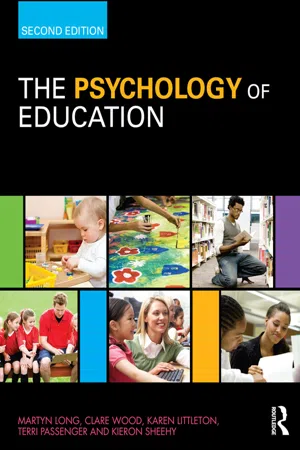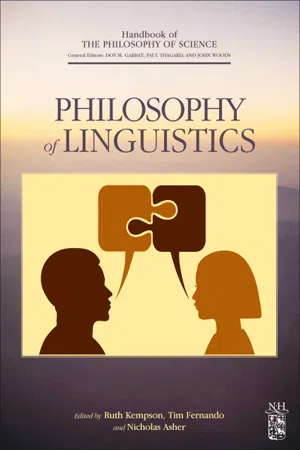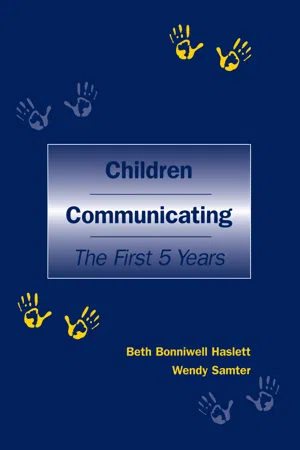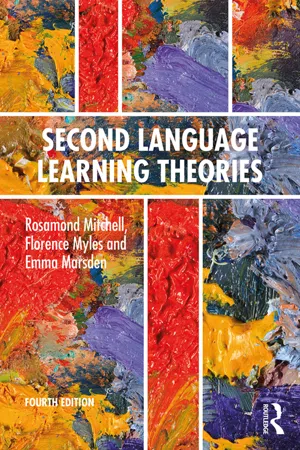Languages & Linguistics
Key Concepts in Language and Linguistics
"Key Concepts in Language and Linguistics" covers fundamental ideas in the field, such as phonetics, syntax, semantics, and pragmatics. It explores the structure and function of language, including its sounds, grammar, meaning, and use in communication. The book provides a comprehensive overview of key linguistic concepts and their relevance to understanding language and its role in society.
Written by Perlego with AI-assistance
Related key terms
Related key terms
1 of 4
Related key terms
1 of 3
4 Key excerpts on "Key Concepts in Language and Linguistics"
- eBook - ePub
- Martyn Long, Clare Wood, Karen Littleton, Terri Passenger, Kieron Sheehy(Authors)
- 2010(Publication Date)
- Routledge(Publisher)
There are many interconnected ways in which language can be seen as a central component of the educational process. Perhaps most importantly, language is the major way of forming and developing concepts, and using these to express understanding and to communicate with other people. Language therefore depends on, and is a basis for, learning and memory, as well as general thinking abilities. Because of its central role in education, English is a core subject in the National Curriculum of England and Wales, and children’s progress is assessed at the end of the various Key Stages by means of SATs and the GCSE examinations. Traditionally, at school, the emphasis tends to be on developing competency with written forms of language, and less emphasis is put on competency in oral communication. However, there is an increasing recognition of language as the basis for cognitive development and problem-solving, and research has examined the impact that teaching children to ‘think together’ through spoken language can have on their academic attainment, as you will see.What is language?Language can be thought of simply as a system of symbols (vocal noises, marks on a page or hand movements) that we use to communicate with others. According to such a definition, all animals ‘speak’ a language to other members of their community, but human language is seen as distinct from the communication systems of other species in important ways. In particular, Jean Aitchison (2008) notes that, although there are many similarities between human and non-human languages, human language is distinctive in several key respects.1 Semanticity: the symbols that we use in our language (spoken, written or signed words) carry meaning. It has not yet been demonstrated whether or not units of animal language are ‘meaningful’ in the same way.2 Duality and displacement: - eBook - ePub
- Dov M. Gabbay, Paul Thagard, John Woods(Authors)
- 2012(Publication Date)
- North Holland(Publisher)
One of the tasks often assigned to a theory of language is the search for ‘linguistic universals’, for features of individual languages which appear to be constant across them. The study of such universals is then considered as the study of ‘language as such’ — of a type whose tokens are the individual natural (and possibly also some artificial) languages. Theoreticians of language often differ in their views of the ratio of the universal vs. idiosyncratic components of an individual language.At one extreme, there are ‘universalist’ theories according to which all languages are mere minor variations of a general scheme. Thus, Wierzbicka [1980] proposed that there is a minimal, generally human conceptual base such that every possible language is merely its elaboration. Also, Chomsky suggests that the most important inborn linguistic structures are the same for every individual — learning only delivers vocabulary and fixes a few free parameters of this universal structure.At the other extreme, there are those who doubt that there are any important linguistic universals at all. These ‘linguistic relativists’ claim that, at least as for semantics, individual languages may well be (and sometimes indeed are) so ‘incommensurable’ that their respective speakers can not even be conceived as living within the same world. The idea of such relativism goes back to Willhelm von Humboldt, and within the last century it was defended both by linguists [Sapir, 1921 ; Whorf, 1956 ] and by philosophers [Cassirer, 1923 ; Goodman, 1978 ].6 Prospects
It is clear that a language, being both a ‘thing’ among other things of our world and - eBook - ePub
Children Communicating
The First 5 Years
- Beth Bonniwell Haslett, Wendy Samter(Authors)
- 2020(Publication Date)
- Routledge(Publisher)
The study of language as a system (in its idealized form) has focused on three subsystems: grammar (or linguistic structure), semantics (or linguistic meaning), and phonology (the sound system of a language). Linguists have assessed both the universal aspects of development in each linguistic subsystem and the specific features of each language which must be acquired by young children. The learning features general to all languages are viewed as linguistic universals; some have argued that these universals reflect humans’ innate predisposition to acquire language.Studies of grammar focus on the structure of language and its acquisition by young children. Theories of language need to account for the grammaticality of utterances and how different linguistic forms can mean the same thing. For example, the statements ‘John hit Sally’ and ‘Sally was hit by John’ have the same meaning, although the former is an active sentence and the latter a passive one.Semantic research focuses on the meaning of words and utterances and tries to account for young children’s mastery of both. Meaning incorporates both referential and expressive functions of language. Referential language refers to the meanings humans assign to concrete objects and things; expressive language refers to the expression of emotion and abstract concepts or ideas. Single words are combined into phrases and sentences that convey meaning; thus, young children need to interpret connected discourse. Part of children’s interpretive skill also relies on the conventional meanings embedded in specific social contexts, such as taking a bath, reading bedtime stories, conducting an argument, or preparing supper.The phonological system of a language consists of the finite set of phonemes used in a particular language. Children need to separate language sounds from nonlanguage sounds and to understand that language sounds form meaningful words and syllables. An understanding of the sound system of a language also involves recognizing intonation patterns and producing appropriate patterns in timing, stress, and pausing. - eBook - ePub
Second Language Learning Theories
Fourth Edition
- Rosamond Mitchell, Florence Myles, Emma Marsden(Authors)
- 2019(Publication Date)
- Routledge(Publisher)
A further debate in contemporary linguistics which is relevant to SLL theorizing has to do with whether language is viewed primarily as a formal or a functional system. From a formal linguistics perspective such as that adopted in structuralist or Chomskyan theory, language comprises a set of abstract elements (parts of speech, morphosyntactic features, phonemes and so on) which are combined together by a series of rules or procedures. Semantics forms part of this formal system, but does not drive it (for discussion see, for example, Rispoli, 1999).From a functionalist perspective, on the other hand, research and theorizing must start with the communicative functions of language, and functionalists seek to explain the structure of language as a reflection of meaning-making. For example, a speaker’s intention to treat a particular piece of information as already known to their interlocutor, or alternatively as new for them, is seen by theories such as Halliday’s systemic functional grammar as motivating particular grammar phenomena such as clefting (fronting a piece of information within a sentence: It was my mother who liked jazz). Theoretical linguists who have adopted this perspective in varying ways, and whose work has been important for both L1 and L2 research, include Givón (e.g. 1979, 1985), Halliday (e.g. Halliday & Matthiessen, 2014), Lakoff (1987), Langacker (1987) and L. Talmy (2000) (and see Chapter 7 for discussion of this perspective in L2 research).A third theoretical perspective which is important in L2 research is that of emergentism. From this viewpoint, language does not have fixed abstract, underlying representations. Rather, language is conceived of as emerging in a dynamic fashion from language use, and its form is strongly and continuously influenced by statistical patterns detected by the learner in the surrounding input. Emergentist perspectives are explored in Chapters 4 and 10
Index pages curate the most relevant extracts from our library of academic textbooks. They’ve been created using an in-house natural language model (NLM), each adding context and meaning to key research topics.
Explore more topic indexes
Explore more topic indexes
1 of 6
Explore more topic indexes
1 of 4



